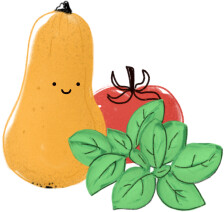Rutabaga / Swedish turnip

Rutabaga / Swedish turnip
Brassica napus ssp. Napobrassica
Plant family
Crucifers (Brassicaceae)
Also known as
Neep
Season Overview
Sowing
Harvest
J
F
M
A
M
J
J
A
S
O
N
D
Details
Light requirement
Semi-shaded
Water requirement
Moist
Soil
Medium (loamy)
Nutrient requirement
High
Plant distance
40 cm
Row spacing
40 cm
Seeding depth
1 cm
Instructions
The season for this plant is over. The following instructions are for the next season.
Beginning of May
Sowing
Beginning of May
Fertilizing
Every two Weeks
Mid of May
Thinning
Description
Turnip is a subspecies of rapeseed. It is to be distinguished from the turnip and is considered a typical winter vegetable.
Origin:
The actual origin is unclear. Probably northern or central Europe.
Growing tips
The best time for direct sowing is mid-May to July, after which the turnips will not reach their full size until autumn. The seeds should not be sown too deep, 1 cm sowing depth is ideal. The turnip needs a row spacing of 30-40 cm, within the rows they grow best with a distance of 40 cm from the next plant. When the seedlings have formed the first leaves, you can separate them. Turnip is relatively uncomplicated in its care and does not require any special care. Keep the soil around the turnips nice and loose and moist so that ground fleas don't make themselves comfortable and eat the leaves. Also, a loosened soil encourages the formation of nice beet bodies. Otherwise, it behaves as with cabbage: against cabbage white butterfly, earth fleas and whiteflies helps to cover with a culture protection net. The beets can be harvested into November. Smaller turnips (about 10 -15 cm in diameter) have a more intense flavor; large turnips may tend to be woody, especially if grown under drought and heat. Turnips tolerate short-term frosts well, but should be harvested before prolonged frosts. To harvest, you can simply pull the beets out of the ground by hand if the soil is loose; if the soil is firmer, you can use a digging fork to help loosen the soil a bit beforehand.
Companion Plants
Antagonistic Plants
Diseases
Club root of cabbage
Pests
Cabbage white
Cabbage fly
Nematodes
White fly